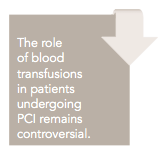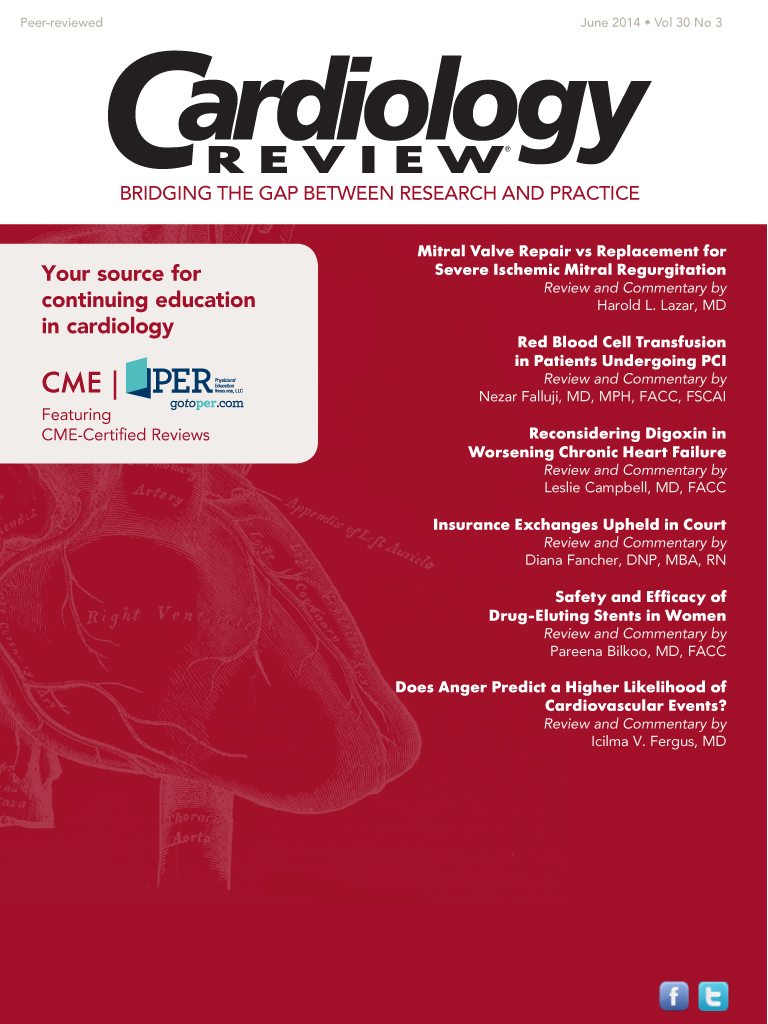Publication
Article
Cardiology Review® Online
Red Blood Cell Transfusion in Patients Undergoing PCI
Author(s):
The role of blood transfusions in patients undergoing percutaneous coronary intervention remains controversial.

Nezar Falluji, MD, MPH, FACC, FSCAI
Review

JAMA.
Sherwood MW, Wang Y, Curtis JP, et al. Patterns and outcomes of red blood cell transfusion in patients undergoing percutaneous coronary intervention. 2014;311:836-843.
Patients undergoing percutaneous coronary intervention (PCI) are at particularly high risk for bleeding, and such patients are frequently anemic secondary to comorbidities. In managing anemia in patients with coronary artery disease (CAD), the role of blood transfusion therapy remains rather controversial, with a growing body of evidence suggesting that it may be harmful.1
Study Design
Sherwood et al conducted a retrospective cohort study to explore blood transfusion practices among patients undergoing PCI and the association of transfusion with adverse cardiac outcomes across US hospitals.7 They analyzed the data of 2,258,711 patients who underwent PCI from July 2009 to March 2013, using the CathPCI registry. The CathPCI registry is an initiative of the American College of Cardiology Foundation and the Society of Cardiovascular Angiography and Interventions, and is the largest ongoing US registry of PCI, with more than 1400 participating sites (approximately 85% of all cardiac catheterization laboratories).8 The authors excluded patients who did not undergo PCI; patients with missing data on bleeding events, procedural complications, or discharge status; and patients who underwent in-hospital coronary artery bypass graft surgery.
The primary outcome was blood transfusion in the overall population. Blood transfusion rates were calculated in the overall population, by hospital, and by the occurrence of a bleeding event. The transfusion rates were also calculated quarterly from the third quarter of 2009 through the first quarter of 2013 to assess for change in transfusion trends. Secondary outcomes included in-hospital myocardial infarction (MI), congestive heart failure (CHF), cardiogenic shock, stroke, and death.
A hierarchical logistics regression model was used to calculate risk-standardized, site-based rates of transfusion. Variables previously validated in the CathPCI registry mortality and bleeding risk models were used in the regression model.9,10
The hospitals were divided, based on their risk-standardized rates of transfusion, into low (below the 33rd percentile, with transfusion rates <1.78%), medium (between 33rd percentile and 66th percentile, with transfusion rates from 1.78% to <2.79%), and high transfusion groups (above the 66th percentile with transfusion rates ≥2.79%). Transfusion frequencies were then plotted by postprocedural hemoglobin values for each group to determine whether hospital-level transfusion practices were different, specifically by transfusion thresholds.
The study population was divided into cohorts according to whether or not they received a transfusion. To account for potential confounding in the use of transfusion, inverse probability weighting, based on the propensity modeling for transfusion, was used in the logistic regression to determine the association between transfusion and MI, CHF, stroke, and death. The propensity model for transfusion included variables that were validated in the National Cardiovascular Data Registry (NCDR) mortality risk model (such as age, sex, cardiogenic shock, cardiac arrest, prior CHF, diabetes, PCI status, hospital characteristics, etc).9 Secondary analyses were done to assess the association between bleeding event and between preprocedure hemoglobin values, and transfusion rates and outcomes.
P
The overall rate of transfusion was 2.14% (95% confidence interval [CI], 2.13%-2.16%). Quarterly transfusion rates from July 2009 to March 2013 declined from 2.11% (95% CI, 2.03%-2.19%) to 2.04% (95% CI, 1.97%-2.12%) of visits (<0.001 for trend). The majority of hospitals (96.3%) gave a transfusion to less than 5% of their patients, with 25.5% of hospitals transfusing less than 1% of patients. However, 3.7% of hospitals gave more than 5% of their patients a transfusion. High-transfusing hospitals were more likely to be larger, with high PCI volume, to be in the New England and Pacific regions, to be teaching hospitals, and to be urban hospitals.
CommentaryPerhaps Less Is More
T
he study by Sherwood et al is a well-conducted, hypothesis-generating observational study. Its strength stems from the analysis of a large, high-quality contemporary PCI database. The study revealed important observations regarding blood transfusion practices in the context of PCI:
- The rate of blood transfusion in patients undergoing PCI in the United States is trending down, with the minority of hospitals (3.7%) having high transfusion rates.
- Bleeding was a predictor of transfusion, irrespective of hemoglobin value.
- In the absence of bleeding, a hemoglobin value of <8 g/dL was associated with increased transfusion rates.
- Patients who received transfusions were more likely to be older, more often female, and more likely to have comorbidities and to have PCI for a STEMI.
- Blood transfusion, irrespective of bleeding events, was associated (although causality cannot be inferred) with higher in-hospital MI, stroke, or death, except in patients with preprocedural hemoglobin values less than 10 g/dL who had bleeding complications.
The authors acknowledge the inherent limitations of observational studies (such as the inability to control for unmeasured confounders or to infer causality between blood transfusion and adverse events). They also acknowledge that while the CathPCI registry captures data from the majority of the US cardiac catheterization laboratories, it does not include all US hospitals and may not fully represent transfusion practices in the United States.
The results of this study highlight the need for randomized controlled trials to help delineate the appropriate use of blood transfusion in patients undergoing PCI. Blood transfusion is expensive and is therefore associated with the risk of blood-borne infections and other adverse effects (circulatory and immunologic). Pending more definitive data, most experts and guidelines recommend a restrictive transfusion strategy taking into account the clinical assessment of the patient (rather than an absolute hemoglobin or hematocrit value) to guide the decision regarding blood transfusion.
References
JAMA Intern Med.
1. Chatterjee S, Wetterslev J, Sharma A, Lichstein E, Mukherjee D. Association of blood transfusion with increased mortality in myocardial infarction: a meta-analysis and diversity-adjusted study sequential analysis. 2013;173:132-139.
Eur Heart J.
2. Jolicoeur EM, O’Neill WW, Hellkamp A, et al. Transfusion and mortality in patients with ST-segment elevation myocardial infarction treated with primary percutaneous coronary intervention. 2009;30:2575-2583.
JACC Cardiovasc Interv.
3. Nikolsky E, Mehran R, Sadeghi HM, et al. Prognostic impact of blood transfusion after primary angioplasty for acute myocardial infarction: analysis from the CADILLAC (Controlled Abciximab and Device Investigation to Lower Late Angioplasty Complications) Trial. 2009:2:624-32.
JACC Cardiovasc Interv.
4. Shishehbor MH, Madhwal S, Rajagopal V, et al., Impact of blood transfusion on short- and long-term mortality in patients with ST-segment elevation myocardial infarction. 2009;2:46-53.
Am J Cardiol.
5. Aronson D, Dann EJ, Bonstein L, et al. Impact of red blood cell transfusion on clinical outcomes in patients with acute myocardial infarction. 2008;1022:115-119.
JAMA.
6. Rao SV, Jollis JG, Harrington RA, et al. Relationship of blood transfusion and clinical outcomes in patients with acute coronary syndromes. 2004;292:1555-1562.
JAMA.
7. Sherwood MW, Wang Y, Curtis JP, et al. Patterns and outcomes of red blood cell transfusion in patients undergoing percutaneous coronary intervention. 2014;311:836-843.
J Am Coll Cardiol.
8. Brindis RG, Fitzgerald S, Anderson HV, et al. The American College of Cardiology-National Cardiovascular Data Registry (ACC-NCDR): building a national clinical data repository. 2001;37:2240-2245.
Heart.
9. Peterson ED, Roe MT, Chen AY, et al. The NCDR ACTION Registry-GWTG: transforming contemporary acute myocardial infarction clinical care. 2010;96(22):1798-1802.
.
Circ Cardiovasc Interv
10. Mehta SK, Frutkin AD, Lindsey JB, et al. Bleeding in patients undergoing percutaneous coronary intervention: the development of a clinical risk algorithm from the National Cardiovascular Data Registry . 2009. 2(3):222-229.
.
Ann Intern Med.
11. Carson JL, Grossman BJ, Kleinman S, et al., Red blood cell transfusion: a clinical practice guideline from the AABB* 2012;157:49-58.
J Am Coll Cardiol.
12. Yang X, Alexander KP, Chen AY, et al. The implications of blood transfusions for patients with non-ST-segment elevation acute coronary syndromes: results from the CRUSADE National Quality Improvement Initiative. 2005;46(8):1490-1495.
Am J Cardiol.
13. Moscucci M, Ricciardi M, Eagle KA, et al. Frequency, predictors, and appropriateness of blood transfusion after percutaneous coronary interventions. 1998;81:702-707.
JAMA.
14. Consensus conference. Perioperative red blood cell transfusion. 1988;260(18):2700-2703.
Anesthesiology.
15. Practice Guidelines for blood component therapy: a report by the American Society of Anesthesiologists Task Force on Blood Component Therapy. 1996;84(3):732-747.
Br J Haematol.
16. Murphy MF, Wallington TB, Kelsey P, et al. Guidelines for the clinical use of red cell transfusions. 2001;113:24-31.
About the Author
Nezar Falluji, MD, MPH, FACC, FSCAI, is an interventional cardiologist. He serves as the executive director of the Kentucky One Health Cardiovascular Service Line and as co-director of the Transcatheter Valve Program at Saint Joseph Heart and Vascular Institute in Lexington, KY.






